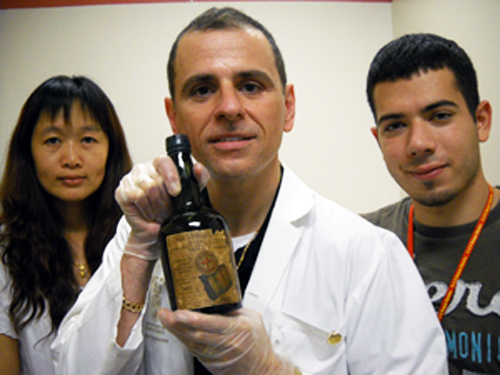
Thomas Edison imbibed Angelo Mariani’s elixir. Queen Victoria was known to favour it. So were two popes of the period. Among a number of Victorian-era coca wines – wine fortified with cocaine and touted as a tonic for body and brain – one favourite was Vin Mariani, developed and promoted by a Paris-based chemist and marketing whiz.
Mariani’s product caught on in European society of the day. But it faced a tougher sell in the United States, where the elixir was barred by federal authorities, says Prof. Massimo Marcone, Department of Food Science.
In a research project that might help point food scientists to potential uses of imaging technology that has been more common in medicine, Marcone has found that Vin Mariani indeed derived its kick not just from wine but also from cocaine.
Using magnetic resonance imaging (MRI) to scan an unopened vintage bottle, Marcone has shown that the Victorian winemaker likely dissolved cocaine in pure alcohol before adding it to his wine.
But it wasn’t the addition of a controlled narcotic that brought in the U.S. authorities in the late 1800s. Only in the early 20th century did American governments begin controlling addictive drugs; Prohibition began in 1920.
Instead, the U.S. government claimed that Mariani’s bottles had been mislabelled. Vin Mariani was touted as a product of France, but the wine was actually prepared in New York, where its signature extract from the coca plant was added.
Says Marcone: “Angelo Mariani would only say that he prepared the wine in the United States, which could mean a lot of things like bottled, aerated, labelled – all things that would not constitute mislabelling a product.”
But the Guelph scientist says his study more than a century later supports the prohibition imposed by the government of the day – even if the authorities missed the point. “The government was correct,” he says. “The wine was mislabelled, as I would have testified if I had been asked to stand before the courts of the day.”
Marcone’s research has revealed the discrepancy in how rather than where the wine was produced.
Vin Mariani was developed in 1863. It was one of many French coca wines sold in the late 19th century that contained cocaine extracted from coca leaves. They were promoted – often in florid terms – for their purported relief of various symptoms, including “brain exhaustion,” nervous depression, sleeplessness and voice fatigue.
Like other wine makers of the time, Mariani was eyeing the United States as a potentially lucrative market.
He had already garnered testimonials from numerous European doctors. He also sought and won endorsements from artists, including composer Charles Gounod, writers H.G. Wells and Jules Verne, and actors Sarah Bernhardt and Fanny Davenport. Edison lent his name to promotional materials. So did popes Leo XIII and Pius X.
“When you start getting these types of people endorsing your product, you can’t go wrong,” says Marcone. He has filled a scrapbook with photos, newspaper and magazine articles, advertisements, letters and other memorabilia collected during his two-year-long research project.

Intrigued by the story and the branding dispute, Marcone contacted collectors, hoping to find an original bottle. Finally he tracked down a 450-millilitre bottle that had been saved from a long-defunct drugstore and kept sealed since 1895 – likely one of the few remaining intact bottles anywhere.
That bottle now occupies a safe in Marcone’s lab. Besides its claim for European provenance, the label recommends dosage amounts: one claret-glassful with meals, half that amount for children.
To learn what was in it, the U of G researcher needed to determine its alcohol content. But how could he do that without opening the bottle? Says Marcone: “You can’t just uncork it. This would be destroying a piece of history.”
He worked with student William Albabish, now in his fourth year of a human kinetics degree, and Sunan Wang, a food science post-doc who completed her graduate degrees at Guelph. They found their answer in MRI used by doctors to look inside the human body – or the animal body. The food scientists initially booked time on MRI diagnostic equipment at the Ontario Veterinary College. They also tested the bottle on a larger machine at a hospital in Hamilton, Ont.
Using the MRI, says Marcone, “We can determine the alcohol content of a bottle of wine to less than one-per-cent variation.”
Vin Mariani’s wine came from the Bordeaux region of France, so the Guelph researchers compared the bottle’s alcohol content with that of other Bordeaux wines of the time. Historical documents state that Bordeaux wines then entering the United States were limited to 12 per cent alcohol by volume.
They found that their bottle contained significantly more alcohol than its maker had claimed, even more than the 14-per-cent outliers in a couple of their test bottles.
“If the alcohol content of Vin Mariani was higher than 14 per cent, then Vin Mariani was made by adding pure alcohol into which the cocaine was dissolved and then diluted into the wine. Pure alcohol would be a good intermediate solvent to dissolve the cocaine into the wine. We have shown that in all probability Angelo Mariani used this method, something he never admitted to the food and drug authorities,” says Marcone.
The Guelph researchers are now writing a paper about their project. Marcone also plans to include Vin Mariani in a new book about foods with psychoactive effects.
He predicts that cheaper imaging techniques will make MRI and related technologies more common in analyzing foods. “This is not only about the history of food but how to use MRI to analyze foods in a non-destructive way.”